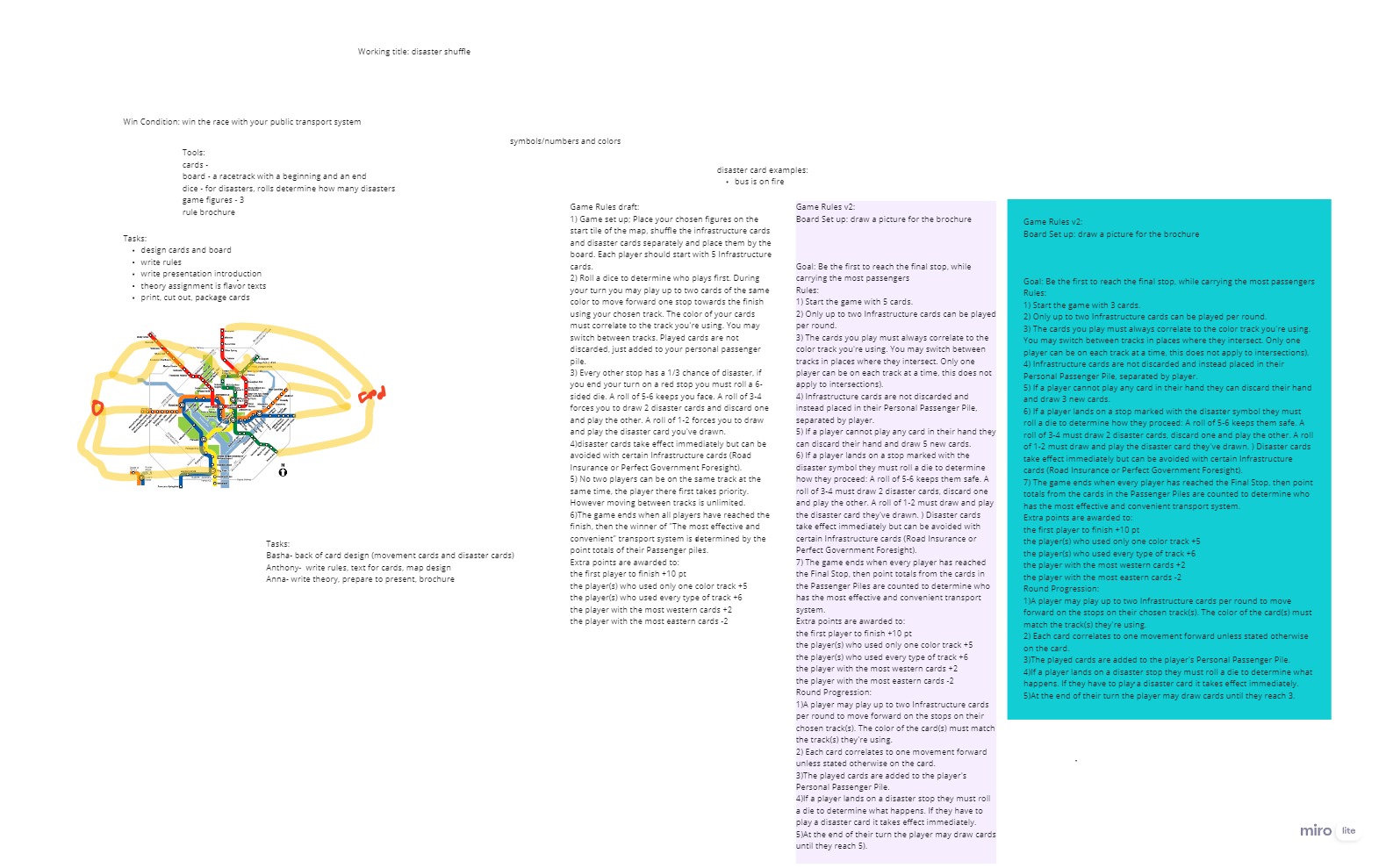Group 2 Module B
Group 2 Module A
Group 2 Module C
Situation in public transport: how few people use the well established transport systems in Western Europe and how they have no idea how great they have it.
Critical Object: boardgame that satirizes the great aspects of transport that Dutch people overlook by contrasting them with the issues experienced by Basha and I in Eastern Europe.
My role: game system designer and writer.
Research:
> Transport and Mobility 2016, published by Statistics Netherlands
"Inhabitants of Zuid-Holland travel greatest distances, with almost 35 billion
kilometres annually. Although this province records the lowest number of
kilometres a day, it has the largest population."
> Cycling in the Netherlands, published by Ministerie van Verkeer en Waterstraat
"In the Netherlands, many people do not make absolute choices between using the car or the bicycle over shorter distances. The image of ‘sometimes the bike and sometimes the car’ is dominant."
> “How can the stigma of public transport as the ‘poor man's vehicle’ be overcome to enhance sustainability and climate change mitigation?”, Daniel Bromley
"The public transport systems of Paris, London, Moscow and other great European cities are marvelous and thoroughly democratic. People do not, and will not, use public transport for the purpose of enhancing sustainability or mitigating climate change. They use it because it is clean, safe, reliably punctual and cheaper than driving"
> The bus stigma: Why it exists, and should we care?, Robbie Webber
"Buses do not provide the same customer experience as trains. Trains are perceived as sleek and modern, while buses are just buses, although London has been trying to change that perception with a complete redesign of their signature double decker models. The route maps and frequencies for trains are more easily understood, and they are more likely to arrive on schedule. Not so with buses whose route maps and schedules can be hard for new riders to understand, although GPS tracking of buses do allow riders to estimate arrival times more reliably than in the past. Buses have stops with shelters, while trains have stations, but that can change as well."
> Car fleet growing faster than population, cbs.nl
"The car ownership rate is highest in the group aged 50 to 64 years: 679 cars per thousand inhabitants. Car ownership is lowest among 18 to 24-year-olds at 172 cars per thousand inhabitants. In comparison, car ownership is over twice as high among the over-80s."
> Public transport in the Netherlands, Ministry of Transport, Public Works and Water Management, https://www.emta.com/IMG/pdf/brochure.pdf
"A distinction frequently drawn is that between ‘captives’ and frequent passengers. Captives are passengers who have no alternative to public transport, while frequent passengers do have an alternative (a car), but sometimes choose the train, bus, tram or metro because it is faster, easier or cheaper. Research has shown that around half of train passengers could also have used a car, but deliberately opted for the train. Among bus users, the share of passengers with a car at their disposal is smaller; in this case it is mainly a choice between the bus and the bicycle."
> Gauging differences in public transport symbolism across national cultures: implications for policy development and transfer
"The bus-based modes, however, were the only modes where the low PDI/individualistic interviewees seemed to begrudgingly admit the presence of negative symbolism, even in cities. Often this was due to a perception that people may be captive to the mode for reasons of price, or that they lived in areas containing cheaper housing. Nobody in this group, however, stated that they or their peers would judge anyone negatively for using a bus."

Game notes:
Rules:
Goal: Be the first to reach the final stop, while carrying the most passengers
Rules:
1) Start the game with 3 cards.
2) Only up to two Infrastructure cards can be played per round.
3) The cards you play must always correlate to the color track you're using. You may switch between tracks in places where they intersect. Only one player can be on each track at a time, this does not apply to intersections).
4) Infrastructure cards are not discarded and instead placed in their Personal Passenger Pile, separated by player.
5) If a player cannot play any card in their hand they can discard their hand and draw 3 new cards.
6) If a player lands on a stop marked with the disaster symbol they must roll a die to determine how they proceed: A roll of 5-6 keeps them safe. A roll of 3-4 must draw 2 disaster cards, discard one and play the other. A roll of 1-2 must draw and play the disaster card they've drawn. ) Disaster cards take effect immediately but can be avoided with certain Infrastructure cards (Road Insurance or Perfect Government Foresight).
7) The game ends when every player has reached the Final Stop, then point totals from the cards in the Passenger Piles are counted to determine who has the most effective and convenient transport system.
Extra points are awarded to:
the first player to finish +10 pt
the player(s) who used only one color track +5
the player(s) who used every type of track +6
the player with the most western cards +2
the player with the most eastern cards -2
Round Progression:
1)A player may play up to two Infrastructure cards per round to move forward on the stops on their chosen track(s). The color of the card(s) must match the track(s) they're using.
2) Each card correlates to one movement forward unless stated otherwise on the card.
3)The played cards are added to the player's Personal Passenger Pile.
4)If a player lands on a disaster stop they must roll a die to determine what happens. If they have to play a disaster card it takes effect immediately.
5)At the end of their turn the player may draw cards until they reach 3.
Map draft:
Cards: